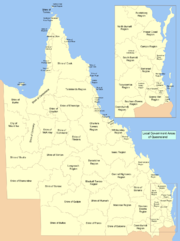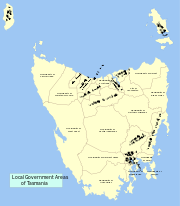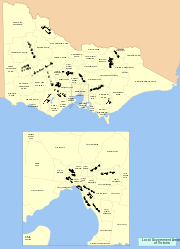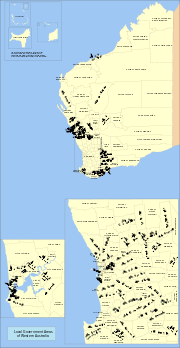Local Government Areas of Australia

Local Government Area (abbreviated LGA) is a term used in Australia (and especially by the Australian Bureau of Statistics) to refer to areas controlled by each individual Local Government.
There is some confusion as to the status of Local Government in Australia. It is not mentioned in the Commonwealth Constitution, nor in most State Constitutional Law. State Governments are responsible for the legislation creating it, and ultimately for supervision. Funding is sometimes provided by State Governments, sometimes by the Federal Government. However, in recent years State governments have increasingly been devolving powers onto LGAs. For example, in Queensland LGAs have been granted the power to independently enact their own (local) legislation (referred to as "Local Laws"), in contrast to the previous system of by-laws.
The generic names of Local Governments vary from state to state; examples include Borough, City, District, Municipality, Region, Rural City, Shire and Town. Many local government areas in New South Wales and some in South Australia no longer possess legal status such as Shire or Municipality, but are simply known as "Areas", and their councils simply "Councils", e.g. Burwood Council instead of Burwood Municipal Council. There are currently about 700[1] Local Government Areas in Australia.
The creation and delimitation of LGAs is the responsibility of the state and territory Governments. In all states and the Northern Territory each incorporated area has an official status.
Another term used, especially for the LGA governing bodies, is G3, meaning the third level of Government in Australia. Commonwealth, State, and LGA. G3 is difficult to accurately place in the structure of Australian Government.
Contents |
By state/territory
New South Wales

There are 152 LGAs in New South Wales, plus the Unincorporated Far West, and Lord Howe Island, which is also unincorporated, although governed by the Lord Howe Island Board. LGAs may be designated cities, municipalities, shires, regions, or have no designation, but in legislation all LGAs are classified as either Cities (C) or Areas (A) (all other types).
Northern Territory
There are 17 LGAs in the Northern Territory, plus unincorporated areas in the Darwin region and the Central Australian region. LGAs are designated as municipalities and shires, regions, or have no designation, but in legislation all LGAs are classified as either Cities (C), Towns (T) and shires (S). There are only councils which are considered municipalities.
Queensland

There are 73 LGAs in Queensland, including the Aboriginal councils which have full Shire Council status from January 2007. LGA status types or classifiers currently in use are: Cities (C), Shires (S), Towns (T) and Island Councils (IC)
South Australia

There are 69 LGAs in South Australia. LGA status types or classifiers currently in use are: Cities (C), Rural Cities (RC), Municipalities/Municipal Councils (M), District Councils (DC), Regional Councils (RegC) and Aboriginal Councils (AC). The Outback Areas Community Development Trust covers more than half the state, but is not in any LGA.
Tasmania

There are 29 LGAs in Tasmania. LGA status types or classifiers currently in use are: Cities (C) and Municipalities (M)
Victoria

There are 79 LGAs in Victoria, with LGA status types or classifiers currently in use are: Cities (C), Rural Cities (RC), Boroughs (B) and Shires (S). There is only one borough (the only one in Australia), the Borough of Queenscliffe.
Western Australia

There are 143 LGAs in Western Australia, which include Christmas Island and the Cocos Islands. LGA status types or classifiers currently in use are: Cities (C), Towns (T) and Shires (S)
Other territories
The Australian Capital Territory, Jervis Bay Territory and the external territories do not have Local Government Areas distinct from their territorial governments.
See also
- Australian Local Government Association
- Local government in Australia
References
- ↑ "About the Australian Local Government Association". Australian Local Government Association. 2 May, 2008. http://www.alga.asn.au/about/. Retrieved 2009-01-05.
External links
|
|||||
|
||||||||||||||||||||